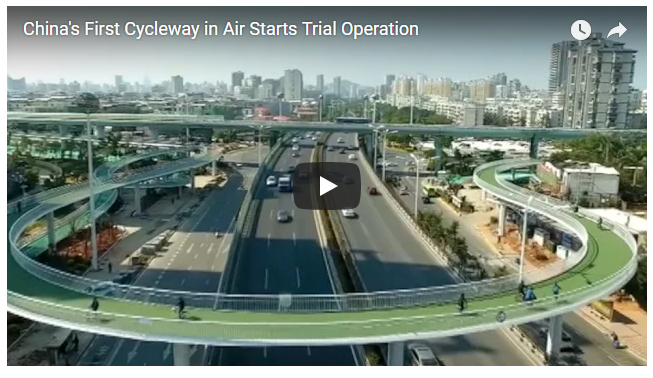China has just built the world’s longest elevated cycle path
We’ve heard of Beijing’s nine million bikes and China referred to as the “Kingdom of Bicycles”. But the reality in many Chinese cities is that the car is king, and getting from A to B has become increasingly difficult – and dangerous – for the country’s cyclists.
However, the emergence of popular bike-sharing schemes, frustration with gridlocked roads, and efforts to tackle the country’s air pollution crisis are all helping to rekindle China’s love affair with cycling.
The southeast city of Xiamen has gone even further with the construction of a 7.6km elevated skyway for bikes – the world’s longest elevated cycle path.
image: Dissing + Weitling Architecture
Connecting the major residential and business sectors of the city, the aerial cycleway sits below Xiamen’s existing overhead bus transport system. At 4.8 m wide it has capacity for over 2000 bikes at a time, and will join up with 11 bus stations and two subway stations. As well as space to park bikes, it will also have bikes available to hire.
Image: Dissing + Weitling Architecture
Designed and completed in six months, the project was the latest in a number of raised cycleways by Danish architects Dissing+Weitling. Another project, the ‘Bicycle Snake’, was completed in 2014. The 230 m bridge connects Copenhagen’s harbour area to the city.
Copenhagen had already cemented its status as a bike-friendly city with a cycle super-highway that connects the city with the suburban town of Albertslund, 22 km away. The eventual aim is to build a network of 28 cycle superhighways, covering 500 km. It is estimated the network will increase the number of cycle lanes in Greater Copenhagen by 15% and reduce public expenditure by €40.3m annually thanks to improved health.
Image: Foster + Partners
Meanwhile, London is among other cities considering proposals for elevated bike paths. Architect Norman Foster unveiled plans to create a 220 km car-free cycle network around the city and surrounds. The city has already introduced a network of cycle superhighways on roads.
Please find the original article here
Written by Charlotte Edmond, Formative Content.
--Future of Construction 10:34, 20 Oct 2017 (BST)
[edit] Related articles on Designing Buildings Wiki
Featured articles and news
RTPI leader to become new CIOB Chief Executive Officer
Dr Victoria Hills MRTPI, FICE to take over after Caroline Gumble’s departure.
Social and affordable housing, a long term plan for delivery
The “Delivering a Decade of Renewal for Social and Affordable Housing” strategy sets out future path.
A change to adoptive architecture
Effects of global weather warming on architectural detailing, material choice and human interaction.
The proposed publicly owned and backed subsidiary of Homes England, to facilitate new homes.
How big is the problem and what can we do to mitigate the effects?
Overheating guidance and tools for building designers
A number of cool guides to help with the heat.
The UK's Modern Industrial Strategy: A 10 year plan
Previous consultation criticism, current key elements and general support with some persisting reservations.
Building Safety Regulator reforms
New roles, new staff and a new fast track service pave the way for a single construction regulator.
Architectural Technologist CPDs and Communications
CIAT CPD… and how you can do it!
Cooling centres and cool spaces
Managing extreme heat in cities by directing the public to places for heat stress relief and water sources.
Winter gardens: A brief history and warm variations
Extending the season with glass in different forms and terms.
Restoring Great Yarmouth's Winter Gardens
Transforming one of the least sustainable constructions imaginable.
Construction Skills Mission Board launch sector drive
Newly formed government and industry collaboration set strategy for recruiting an additional 100,000 construction workers a year.
New Architects Code comes into effect in September 2025
ARB Architects Code of Conduct and Practice available with ongoing consultation regarding guidance.
Welsh Skills Body (Medr) launches ambitious plan
The new skills body brings together funding and regulation of tertiary education and research for the devolved nation.
Paul Gandy FCIOB announced as next CIOB President
Former Tilbury Douglas CEO takes helm.
UK Infrastructure: A 10 Year Strategy. In brief with reactions
With the National Infrastructure and Service Transformation Authority (NISTA).




























